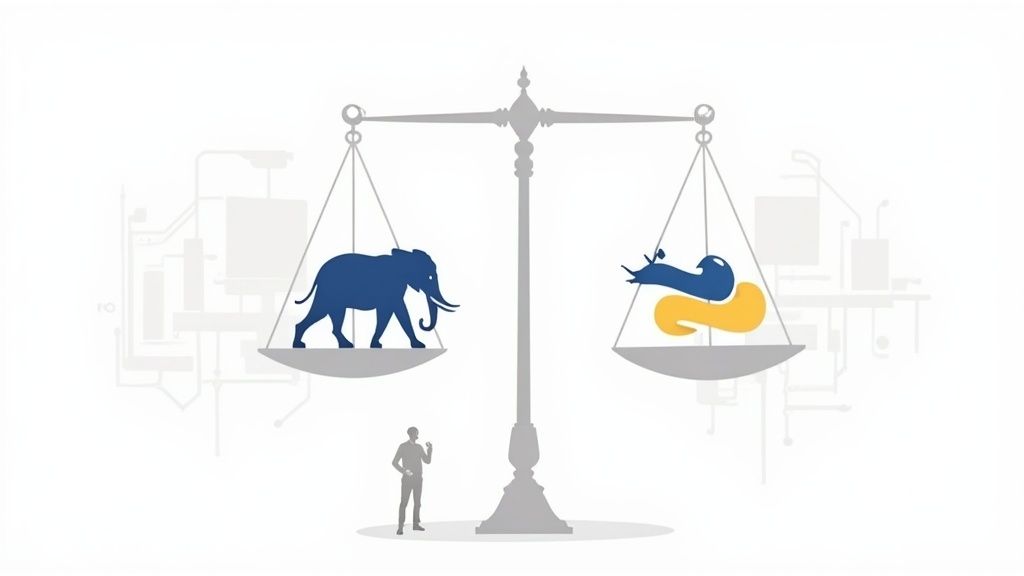
So, you're about to start a new project. You've got a brilliant idea, a blank editor, and a big decision to make. Suddenly, the old PHP vs Python debate pops into your head, and it feels less like a technical choice and more like picking a side in a holy war.
I've been there. Staring at the screen, wondering which path leads to glory and which one leads to a pit of despair filled with legacy code. The truth is, it's not that dramatic. PHP was built from the ground up for the web, while Python is a multi purpose tool that also happens to be fantastic at it, along with data, AI, and a million other things. Your decision really just boils down to the problem you're trying to solve.
The Crossroads Why This Choice Feels So Big
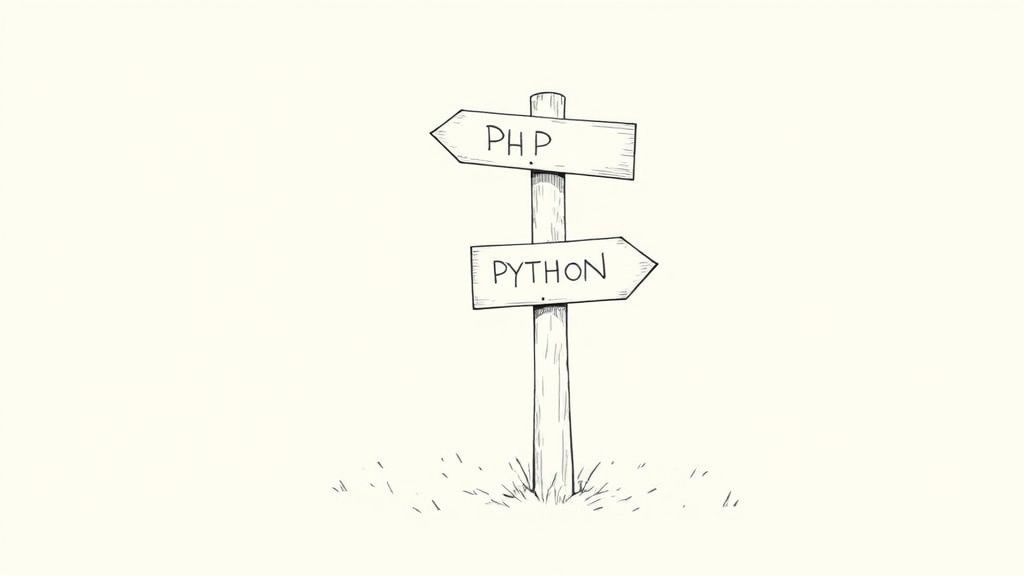
Standing at this crossroads can feel paralyzing. I remember my early days, bouncing between tutorials for both, convinced that picking the "wrong" one would doom my career forever. It's not just about code; it's about choosing the right tool for the job ahead and the community you'll be joining.
Let's take a step back and look at where these two came from. PHP was born and bred for the web. It was a pragmatic tool designed to get dynamic pages up and running with minimal fuss. Think of it as the ultimate specialist, a master craftsman who does one thing exceptionally well. Its original job was to embed logic right into HTML, which is why it became the natural engine for the massive ecosystem of content management systems it powers today.
Python, on the other hand, grew up with a different philosophy: make code beautiful and easy to read. It wasn't built just for the web; it was built for clarity. This simple, powerful idea made it an amazing tool for everything from simple scripts to the complex AI models that are changing our world.
This difference in origin story is clear when you look at the stats. According to the influential TIOBE programming community index, Python has seen a meteoric rise, climbing from 7th place in 2015 to the top spot today, a testament to its massive adoption across countless industries. While PHP still dominates specific web niches like content management, Python's broad appeal has made it a hugely popular choice for modern development.
Quick Glance PHP vs Python
Before we go deeper, here's a high level look at their fundamental differences. Think of this as the tale of the tape before a big fight. This table should give you an immediate feel for where each language shines.
| Attribute | PHP | Python |
|---|---|---|
| Primary Use Case | Server side web development, CMS | General purpose, web, AI, data science |
| Syntax Style | C like, requires semicolons, uses $ for variables |
Clean, readable, uses indentation for blocks |
| Learning Curve | Steeper for beginners due to syntax quirks | Generally considered easier and more intuitive |
| Ecosystem Strength | Massive in web (WordPress, Laravel, Symfony) | Extremely broad (Django, Flask, NumPy, Pandas) |
This gives us a starting point, but the real story is in the details. Let's explore what these differences actually mean for you, the developer sitting in the chair.
Comparing Syntax and How It Feels to Write Code
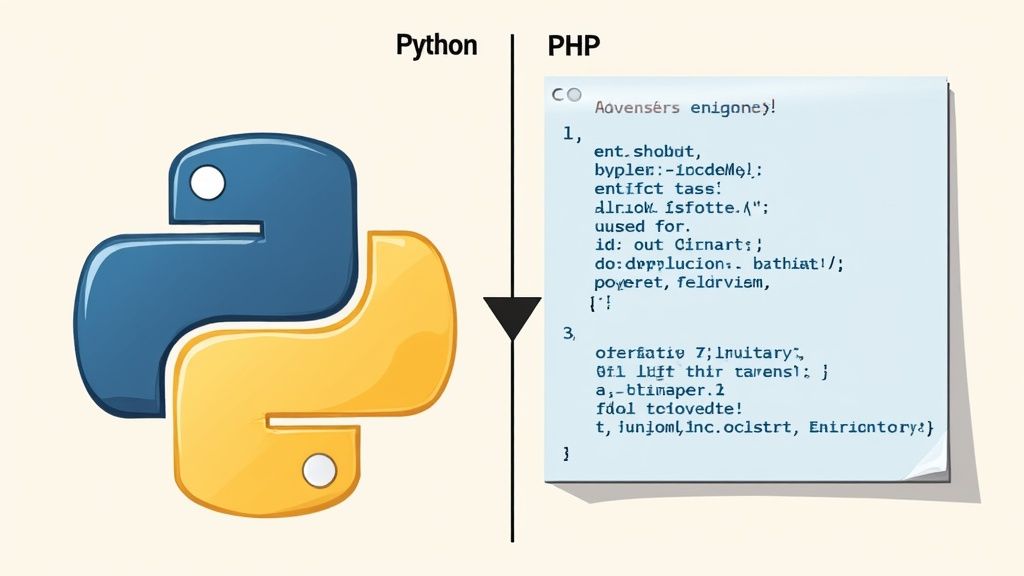
Caption: The developer experience can sometimes feel... different.
Let's get personal for a minute. The whole PHP vs Python argument often boils down to a simple question: how does it feel to write the code? This isn't just about what looks pretty; it directly impacts how fast you can build, how quickly you can squash that bug that's been mocking you for hours, and the sanity of the next poor soul who has to look at your work.
Python has built its entire reputation on a clean, readable syntax. It feels less like writing code and more like writing structured English. This isn't an accident. It's a core design principle baked right into its philosophy, famously known as "The Zen of Python". This obsession with simplicity makes it a favorite for beginners and a huge relief for teams trying to maintain massive codebases over many years.
On the other side of the ring, PHP's C like syntax feels instantly familiar to a lot of developers, especially those who came from C, Java, or C++. But it's undeniably more verbose. The constant use of dollar signs for variables, semicolons at the end of every line, and different operators for objects versus arrays creates a syntax that is powerful but can feel a bit cluttered.
A Tale of Two Syntaxes
To really see what I mean, let's look at a dead simple task: defining a function to print a greeting. This is where the personalities of the two languages really start to show.
Python Example: A Breath of Fresh Air
Python's syntax is all about clarity. Notice the lack of curly braces or semicolons; the code's structure is defined purely by indentation. It's clean, minimal, and you know exactly what's happening.
def greet_user(name):
# Python uses f strings for easy variable formatting
message = f"Hello, {name}! Welcome to the team."
print(message)
greet_user("Alex")
PHP Example: A Bit More Ceremony
PHP gets the same job done, but with more syntactic ceremony. You need the $ for variables, a semicolon after each statement, and you combine strings with a period. It all works, but there are more rules to keep in your head.
<?php
function greetUser($name) {
// PHP uses the dot for string concatenation
$message = "Hello, " . $name . "! Welcome to the team.";
echo $message;
}
greetUser("Alex");
?>
The difference here might seem small. But now imagine these tiny syntactic taxes adding up over thousands of lines of complex logic.
The Real World Impact
I once burned an entire hour debugging a PHP script, tearing my hair out, only to find I'd missed a single semicolon. While modern IDEs can catch this, it highlights a fundamental difference in philosophy. Python is designed from the ground up to prevent these kinds of trivial errors by having a less complex syntax in the first place.
Python's design philosophy is often summarized as "There should be one, and preferably only one, obvious way to do it." This principle dramatically reduces cognitive load, letting you focus more on solving the actual problem and less on the language's specific rules.
Ultimately, the goal isn't to crown one as "easier" but to find the style that clicks with how your brain works. Do you prefer the explicit, structured nature of PHP, or does Python's minimalist approach feel more natural? This choice will shape your day to day coding life.
Analyzing Performance When the Rubber Meets the Road
Everyone wants the simple answer: which one is faster? But in development, the honest answer is almost always, "it depends." The PHP vs Python performance debate isn't about a straight up drag race; it's about understanding what kind of race you're even running.
Old timers like me remember when PHP's performance was a bit of a running joke. Early versions could be sluggish, but hanging onto that narrative today is just plain wrong. The introduction of the JIT (Just In Time) compiler in PHP 8 was a genuine game changer, delivering massive speed boosts that put it in a completely different league for web requests. Modern PHP is a different beast entirely.
Python, as an interpreted language, has a reputation for starting a bit slower. Its core strength was never raw request response speed but its incredibly powerful computational libraries. That said, tools like PyPy can dramatically speed up Python code, sometimes even outperforming standard CPython for long running processes.
Latency vs Throughput in Practice
Before we go deeper, here's what you should have in mind. We have to talk about two critical metrics. A fantastic resource on this topic explains the difference between latency vs throughput and how they shape system design. In short, PHP often excels at low latency for web requests. It can process a single user's request incredibly quickly.
This makes it a monster for high traffic APIs and content heavy websites where snappy page loads are everything. In many benchmarks covering common web tasks like database queries and template rendering, a well tuned PHP application can often beat a similar Python setup right out of the box.
Think about a system handling thousands of simultaneous, simple API calls. PHP's "shared nothing" architecture gives it a huge advantage here. This approach is a cornerstone of many scalable systems, and if you're building distributed services, our guide on microservices architecture best practices is a must read.
Where Python Pulls Ahead
But the story flips completely when the workload gets computationally heavy.
Imagine you're building a feature that needs to analyze a massive dataset, process an image, or run a machine learning model before sending back a result. This is where Python truly shines. I once worked on a project where we had to generate complex financial reports on the fly. We tried it with PHP first, and the requests were timing out left and right. The moment we offloaded that specific task to a Python microservice, the problem vanished.
In these scenarios, Python's ecosystem of highly optimized C based libraries like NumPy and Pandas gives it a decisive edge. These libraries offload the heavy lifting to low level code, making Python incredibly fast for complex data processing tasks.
So, the choice becomes clear once you define the job. For raw web request handling and straightforward database operations, modern PHP is a formidable contender. But for any application touching on heavy computation, data science, or AI, Python's specialized ecosystem makes it the more practical and performant choice.
Navigating Frameworks and Ecosystems The Tools in the Workshop
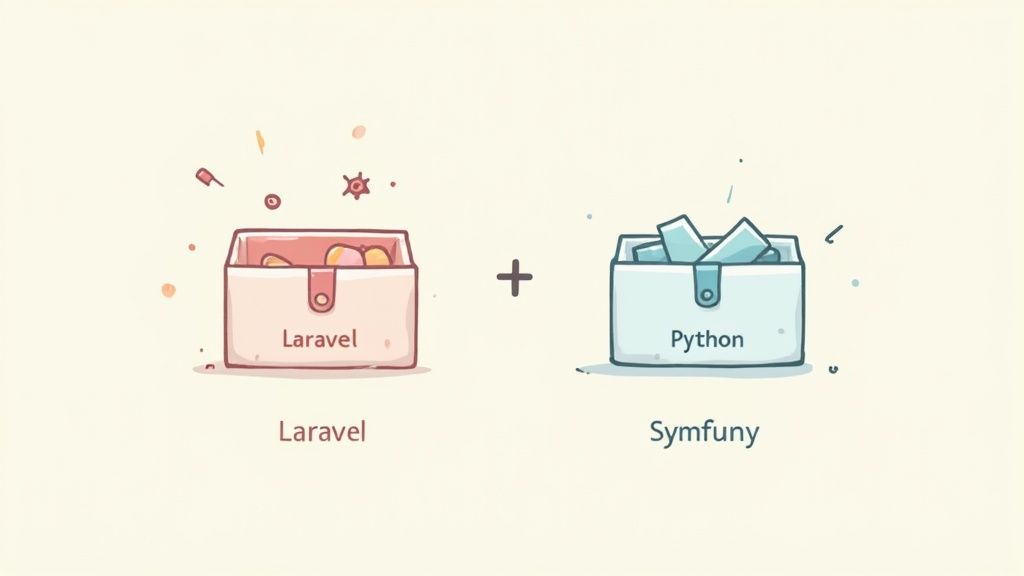
Choosing a language isn't just about syntax; it's about plugging into an entire ecosystem. When you pick PHP or Python, you're also choosing the community, the tools, and the frameworks that come along for the ride. It's like deciding between two incredible workshops, each packed with specialized tools for different jobs.
For a lot of us, the PHP vs Python decision really comes down to the strength of these support systems. A language, after all, is only as good as the libraries and frameworks that help you build faster and more reliably.
The PHP Workshop Web Focused and Robust
PHP's ecosystem is a finely tuned machine, purpose built for web development. It's pragmatic, battle tested, and has one main goal: creating dynamic experiences on the internet.
- Laravel: This framework is often the reason developers fall in love with modern PHP. Its elegant syntax and all in one toolkit make building complex applications feel almost effortless.
- Symfony: A collection of reusable components and a beast of a framework in its own right, Symfony is the foundation for massive projects like Drupal and Magento.
- WordPress: You just can't talk about the PHP ecosystem without mentioning WordPress. This behemoth powers a huge chunk of the web, creating a durable, massive demand for PHP developers who can build themes and plugins.
The core strength of the PHP ecosystem is its laser focus. If your main objective is to build a content management system, an ecommerce platform, or a traditional web app, PHP's tools are built for that exact job. They offer a direct, well trodden path to a finished product.
The Python Workshop Versatile and Expansive
Python's ecosystem is much broader, which makes sense for a general purpose language. It's a champ at web development but also completely dominates fields like data science, machine learning, and automation.
Its popularity just keeps climbing. Recent Stack Overflow survey data shows a 7 percentage point increase in its adoption from 2024 to 2025. This surge is all thanks to its powerful and diverse set of libraries. You can check out more on these technology trends and see how Python is shaping the industry on Stack Overflow's 2025 survey.
Here are the standout tools in Python's workshop:
- Django: Known as the "batteries included" framework, Django gives you everything you need right out of the box to build secure and scalable web apps fast. It enforces best practices, which can be a real lifesaver on big projects. If you're just getting started, our guide on starting a Django project without the headaches can help you get moving.
- Flask: This is a minimalist microframework that gives you total flexibility. Flask provides the essentials and lets you choose the rest, making it perfect for smaller apps, APIs, or for developers who want complete control.
- Data Science & AI Libraries: This is where Python has no competition. Libraries like NumPy, Pandas, and TensorFlow are the global standards for data analysis and machine learning. This makes Python the default language for any data heavy application.
Ultimately, digging into these ecosystems reveals the true personality of each language. PHP offers a specialized, powerful toolkit for the web. Python, on the other hand, provides a versatile set of tools for a huge range of problems, including web development. The specific needs of your project will tell you which workshop has the right tools for the job.
Understanding the Job Market and Community
Picking a language isn't just about syntax and frameworks; it's a career decision. When you go deep into PHP or Python, you're not just learning code. You're joining a community and betting on a specific corner of the job market. I've watched brilliant developers succeed in both ecosystems, but their daily lives and career paths look very different.
PHP has a massive, battle hardened community. Seriously. If you get stuck on a problem, it's almost guaranteed someone has already solved it, written a detailed blog post about it, and answered it on Stack Overflow ten years ago. It's an incredibly supportive environment for that reason. The demand for PHP developers is still incredibly strong, especially for roles centered around WordPress, Drupal, or the countless legacy systems that quietly power a huge slice of the internet.
Python's Expanding Frontier
Python's community feels different. It's less about a single domain and more about a shared enthusiasm for solving a wide array of problems. It's a wonderfully diverse group spanning web development, data science, machine learning, and automation. You'll find academics, scripters, and hardcore backend engineers all rubbing shoulders.
This diversity creates a job market with incredible flexibility. A developer I know spent last year building a web API with Django, and this year she's scripting data pipelines for an analytics firm. Her core Python skills were transferable.
This infographic does a great job of visualizing how your career goals might push you toward one language or the other.
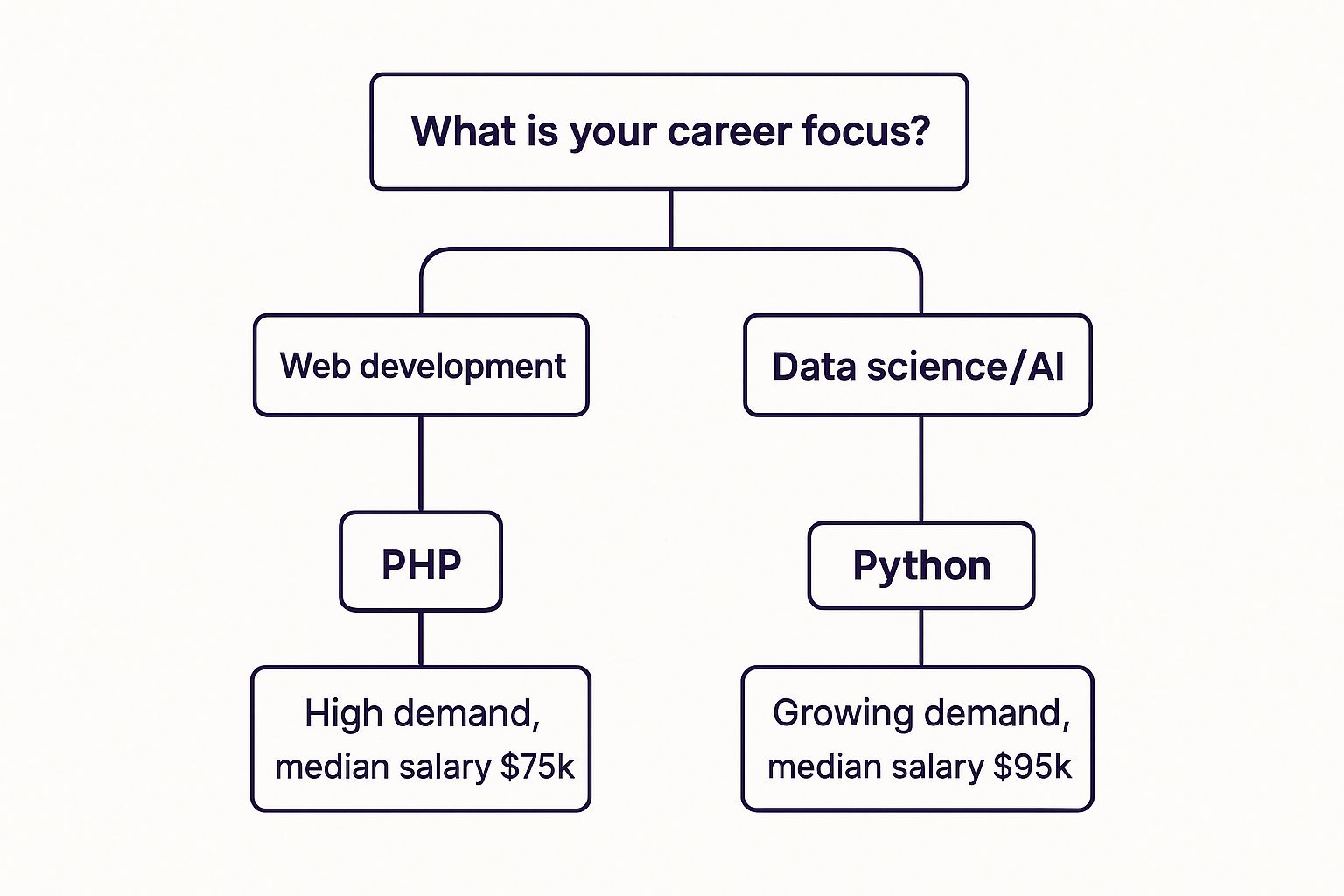
The divergence is pretty clear: PHP absolutely dominates its traditional web development niche, while Python's astronomical growth is being pulled along by the explosive demand in data science and AI.
For a long time, PHP was the undisputed king of server side web development, but Python's rise has been meteoric. Looking at the numbers for 2025, Python is the most popular programming language globally, with a market share of around 29.48%. PHP, by comparison, sits at 6.49%. This shift really highlights Python's incredible versatility, but don't let it fool you. PHP remains an essential, in demand skill within its core web and ecommerce strongholds.
At the end of the day, both languages offer solid, stable career paths. The real question isn't which is "better," but which ecosystem is building things that you find genuinely exciting.
No matter which path you choose, showing off your work is key. Learning about creating an impactful online portfolio can be just as important as the code you write, helping you showcase your projects and stand out to employers.
So Which One Should You Actually Choose
We've torn down the syntax, benchmarked performance, and mapped out the ecosystems. Now it's time to connect the dots and answer the big question in the PHP vs Python debate: which one is right for your project?
The key is to stop asking "which is better?" and start asking "which is best for this?" Shifting that perspective is everything. Your project's specific needs, not popular opinion or what you used last time, should be your guide.
Scenarios Where PHP Is the Pragmatic Choice
If your project lives squarely in the traditional web world, PHP often provides the most direct path from A to B. Its entire ecosystem was purpose built for these tasks, creating a development experience that just flows.
Consider reaching for PHP when you are:
- Building a content focused website: For blogs, portfolios, or corporate sites, pulling in a system like WordPress is brutally efficient.
- Developing an ecommerce store: Frameworks like Laravel and platforms like Magento give you robust, ready to go solutions for online retail.
- Integrating with an existing CMS: If the job involves building plugins or themes for WordPress, Drupal, or Joomla, PHP is the native tongue. It's the only practical choice.
In these situations, PHP's specialized toolset means you aren't reinventing the wheel. You're standing on the shoulders of decades of focused development to get your product out the door faster.
When to Unquestionably Choose Python
But the moment your project's needs step outside the bounds of traditional web development, Python becomes the undisputed champion. Its sheer versatility and ridiculously powerful libraries open doors that are simply locked shut in the PHP world.
Python is the no brainer choice if your project involves:
- Data analysis or visualization: Libraries like Pandas and Matplotlib make complex data wrangling feel almost trivial.
- Machine learning or AI: With TensorFlow, PyTorch, and Scikit learn, Python is the undisputed global standard for AI development.
- Scientific and numeric computing: For heavy algorithms or mathematical modeling, NumPy and SciPy deliver performance that PHP can't touch.
- Automation and scripting: Its clean, readable syntax makes it perfect for writing maintenance scripts and automating backend processes.
Picking the right tool is a massive part of your project's foundation. For a much deeper dive, our guide on how to choose a technology stack without losing your mind can give you a solid framework for making these big decisions.
Key Takeaways Let's Land This Plane
Okay, let's pause and reflect. We've covered a lot of ground. If you remember nothing else from this guide, remember these key points:
- It's About the Job, Not the Tool: The PHP vs Python debate isn't about which language is "better." It's about which one is the right tool for the specific job you have in front of you.
- PHP Is a Web Specialist: For traditional web applications, content management, and ecommerce, PHP's ecosystem is battle tested and incredibly efficient.
- Python Is a Versatile Powerhouse: For anything involving data science, AI, machine learning, or complex backend logic, Python's expansive libraries give it a massive advantage.
- Developer Experience Matters: Python's clean syntax is generally easier for beginners and reduces cognitive load, while PHP's C like syntax may feel more familiar to experienced developers.
- Performance Is Nuanced: Modern PHP is very fast for web requests. Python excels at computationally intensive tasks. Don't believe old myths.
- Both Offer Strong Career Paths: You can build a fantastic career with either language. The choice depends on whether you want to specialize in the web (PHP) or have flexibility across many domains (Python).
Feeling stuck architecting a complex system that needs the best of both worlds? At Kuldeep Pisda, I help startups design and implement production grade applications, from scalable Django backends to AI powered features. Let's build something robust together. Find out more at https://kdpisda.in.
Become a subscriber receive the latest updates in your inbox.
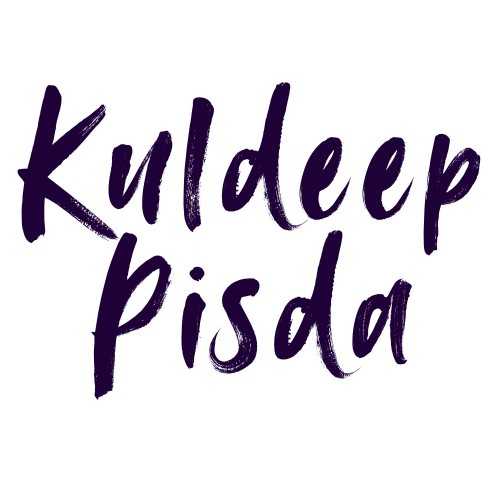

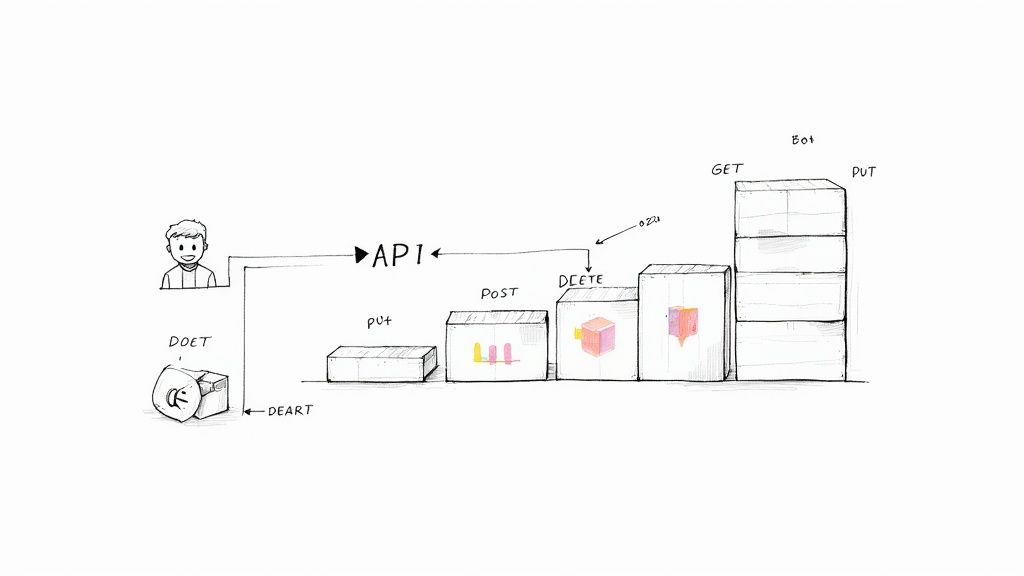
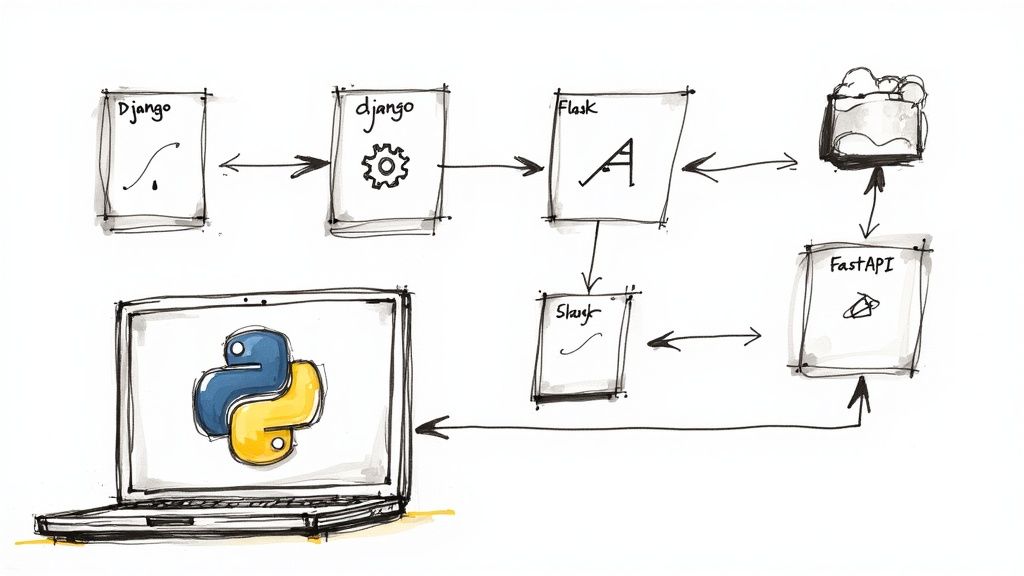
Member discussion